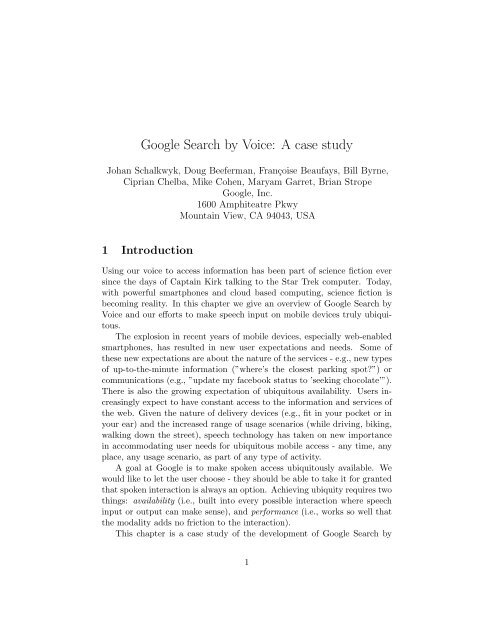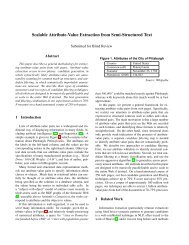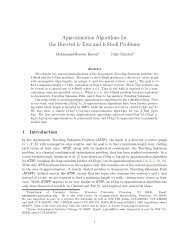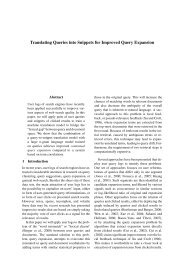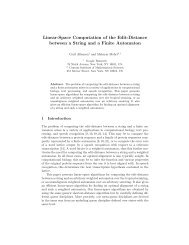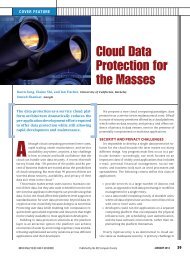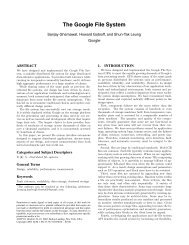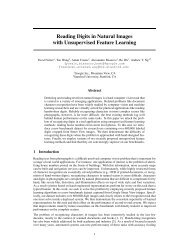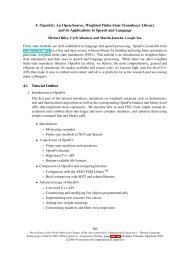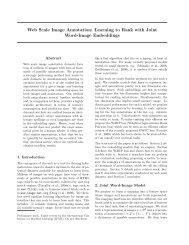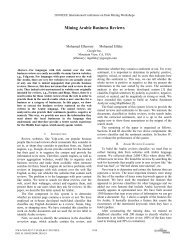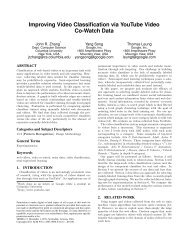Google Search by Voice: A case study - Research at Google
Google Search by Voice: A case study - Research at Google
Google Search by Voice: A case study - Research at Google
You also want an ePaper? Increase the reach of your titles
YUMPU automatically turns print PDFs into web optimized ePapers that Google loves.
<strong>Google</strong> <strong>Search</strong> <strong>by</strong> <strong>Voice</strong>: A <strong>case</strong> <strong>study</strong><br />
Johan Schalkwyk, Doug Beeferman, Françoise Beaufays, Bill Byrne,<br />
Ciprian Chelba, Mike Cohen, Maryam Garret, Brian Strope<br />
<strong>Google</strong>, Inc.<br />
1600 Amphite<strong>at</strong>re Pkwy<br />
Mountain View, CA 94043, USA<br />
1 Introduction<br />
Using our voice to access inform<strong>at</strong>ion has been part of science fiction ever<br />
since the days of Captain Kirk talking to the Star Trek computer. Today,<br />
with powerful smartphones and cloud based computing, science fiction is<br />
becoming reality. In this chapter we give an overview of <strong>Google</strong> <strong>Search</strong> <strong>by</strong><br />
<strong>Voice</strong> and our efforts to make speech input on mobile devices truly ubiquitous.<br />
The explosion in recent years of mobile devices, especially web-enabled<br />
smartphones, has resulted in new user expect<strong>at</strong>ions and needs. Some of<br />
these new expect<strong>at</strong>ions are about the n<strong>at</strong>ure of the services - e.g., new types<br />
of up-to-the-minute inform<strong>at</strong>ion (”where’s the closest parking spot?”) or<br />
communic<strong>at</strong>ions (e.g., ”upd<strong>at</strong>e my facebook st<strong>at</strong>us to ’seeking chocol<strong>at</strong>e’”).<br />
There is also the growing expect<strong>at</strong>ion of ubiquitous availability. Users increasingly<br />
expect to have constant access to the inform<strong>at</strong>ion and services of<br />
the web. Given the n<strong>at</strong>ure of delivery devices (e.g., fit in your pocket or in<br />
your ear) and the increased range of usage scenarios (while driving, biking,<br />
walking down the street), speech technology has taken on new importance<br />
in accommod<strong>at</strong>ing user needs for ubiquitous mobile access - any time, any<br />
place, any usage scenario, as part of any type of activity.<br />
A goal <strong>at</strong> <strong>Google</strong> is to make spoken access ubiquitously available. We<br />
would like to let the user choose - they should be able to take it for granted<br />
th<strong>at</strong> spoken interaction is always an option. Achieving ubiquity requires two<br />
things: availability (i.e., built into every possible interaction where speech<br />
input or output can make sense), and performance (i.e., works so well th<strong>at</strong><br />
the modality adds no friction to the interaction).<br />
This chapter is a <strong>case</strong> <strong>study</strong> of the development of <strong>Google</strong> <strong>Search</strong> <strong>by</strong><br />
1
<strong>Voice</strong> - a step toward our long term vision of ubiquitous access. While the<br />
integr<strong>at</strong>ion of speech input into <strong>Google</strong> search is a significant step toward<br />
more ubiquitous access, it posed many problems in terms of the performance<br />
of core speech technologies and the design of effective user interfaces. Work<br />
is ongoing - the problems are far from solved. However, we have, <strong>at</strong> least,<br />
achieved a level of performance such th<strong>at</strong> usage is growing rapidly, and many<br />
users become repe<strong>at</strong> users.<br />
In this chapter we will present the research, development, and testing<br />
of a number of aspects of speech technology and user interface approaches<br />
th<strong>at</strong> have helped improve performance and/or shed light on issues th<strong>at</strong> will<br />
guide future research. There are two themes which underlie much of the<br />
technical approach we are taking: delivery from the cloud and oper<strong>at</strong>ing <strong>at</strong><br />
large scale.<br />
Delivery from the cloud: Delivery of services from the cloud enables a<br />
number of advantages when developing new services and new technologies.<br />
In general, research and development <strong>at</strong> <strong>Google</strong> is conducted ”in-vivo” —<br />
as part of actual services. This way, we benefit from an ongoing flow of real<br />
usage d<strong>at</strong>a. Th<strong>at</strong> d<strong>at</strong>a is valuable for guiding our research in the directions<br />
of most value to end-users, and supplying a steady flow of d<strong>at</strong>a for training<br />
systems. Given the st<strong>at</strong>istical n<strong>at</strong>ure of modern speech recognition systems,<br />
this ongoing flow of d<strong>at</strong>a for training and testing is critical. Much of the<br />
work described below, including core technology development, user interface<br />
development, and user studies, depends critically on constant access to d<strong>at</strong>a<br />
from real usage.<br />
Oper<strong>at</strong>ing <strong>at</strong> scale: Mobile voice search is a challenging problem for<br />
many reasons - for example, vocabularies are huge, input is unpredictable,<br />
and noise conditions may vary tremendously due to the wide-ranging usage<br />
scenarios while mobile. Additionally, well known issues from earlier deployments<br />
of speech technology, such as dealing with dialectal vari<strong>at</strong>ions, are<br />
compounded <strong>by</strong> the large scale n<strong>at</strong>ure of voice search.<br />
Our thesis in handling these issues is th<strong>at</strong> we can take advantage of the<br />
large amount of compute power, a rapidly growing volume of d<strong>at</strong>a, and the<br />
infrastructure available <strong>at</strong> <strong>Google</strong> to process more d<strong>at</strong>a and model more conditions<br />
than ever done before in the history of speech recognition. Therefore,<br />
many of the techniques and research directions described below are focussed<br />
on building models <strong>at</strong> scale - i.e., models th<strong>at</strong> can take advantage of huge<br />
amounts of d<strong>at</strong>a and the compute power to train and run them. Some of the<br />
approaches discussed will be methods for exploiting large amounts of d<strong>at</strong>a<br />
- for example with ”unsupervised learning”, i.e., the ability to train models<br />
on all the d<strong>at</strong>a th<strong>at</strong> comes in, without the need for human intervention for<br />
2
transcription or labeling. Another key set of issues involve the question of<br />
how to ”grow” models as more d<strong>at</strong>a becomes available. In other words,<br />
given much more d<strong>at</strong>a, we can train richer models th<strong>at</strong> better capture the<br />
complexities of speech. However, there remain many open questions about<br />
the most effective ways to do so.<br />
In addition to taking advantage of the cloud and our ability to oper<strong>at</strong>e<br />
<strong>at</strong> large scale, we also take advantage of other recent technology advances.<br />
The m<strong>at</strong>uring of powerful search engines provides a very effective way to<br />
give users wh<strong>at</strong> they want if we can recognize the words of a query. The<br />
recent emergence of widely-used multi-modal pl<strong>at</strong>forms (smartphones) provides<br />
both a powerful user interface capability and a delivery channel.<br />
This chapter presents the approaches we have taken to deliver and optimize<br />
the performance of spoken search, both from the point of view of<br />
core technology and user interface design. In Section 2 we briefly describe<br />
the history of search <strong>by</strong> voice efforts <strong>at</strong> <strong>Google</strong>. Section 3 provides an in<br />
depth description of the technology employed <strong>at</strong> <strong>Google</strong> and the challenges<br />
we faced to make search <strong>by</strong> voice a reality. In Section 4 we explore the<br />
user interface design issues. Multi-modal interfaces, combining speech and<br />
graphical elements, are very new, and there are many challenges to contend<br />
with as well as opportunities to exploit. Finally, in Section 5 we describe<br />
user studies based on our deployed applic<strong>at</strong>ions.<br />
2 History<br />
2.1 GOOG-411<br />
<strong>Search</strong>ing for inform<strong>at</strong>ion <strong>by</strong> voice has been part of our every day lives since<br />
long before the internet became prevalent. It was already the <strong>case</strong> thirty<br />
years ago th<strong>at</strong>, if you needed inform<strong>at</strong>ion for a local business, the common<br />
approach was to dial directory assistance (411 in the US) and ask an oper<strong>at</strong>or<br />
for the telephone number.<br />
800-GOOG-411 [2] is an autom<strong>at</strong>ed system th<strong>at</strong> uses speech recognition<br />
and web search to help people find and call businesses. Initially this system<br />
followed the well known model of first prompting the user for the “city and<br />
st<strong>at</strong>e” followed <strong>by</strong> the desired business listing as depicted in Figure 1.<br />
This basic dialog has been ingrained in our minds since long before interactive<br />
voice response systems (IVR) replaced all or part of the live oper<strong>at</strong>or<br />
interaction.<br />
Pre-IVR systems use ”store-and-forward” technology th<strong>at</strong> records the<br />
”city-and-st<strong>at</strong>e” the caller is requesting and then plays the city and st<strong>at</strong>e to<br />
3
GOOG411: Calls recorded... <strong>Google</strong>! Wh<strong>at</strong> city and st<strong>at</strong>e?<br />
Caller: Palo Alto, California<br />
GOOG411: Wh<strong>at</strong> listing?<br />
Caller: P<strong>at</strong>xis Chicago Pizza<br />
GOOG411: P<strong>at</strong>xis Chicago Pizza, on Emerson Street. I’ll connect you...<br />
Figure 1: Early dialog for a GOOG-411 query.<br />
the oper<strong>at</strong>or. This frees the oper<strong>at</strong>or from direct interaction with the user<br />
and results in substantial savings of human labor. Additionally, it constrains<br />
the search for businesses to the chosen city.<br />
In 2008 we deployed a new version of GOOG-411 which allowed (and<br />
encouraged) the user to st<strong>at</strong>e their need in a single utterance r<strong>at</strong>her than<br />
in sequential utterances th<strong>at</strong> split apart the loc<strong>at</strong>ion and the business (Figure<br />
2). This was motiv<strong>at</strong>ed <strong>by</strong> our desire to accommod<strong>at</strong>e faster interactions<br />
as well as allow the user gre<strong>at</strong>er flexibility in how they describe their needs.<br />
This approach introduces new speech recognition challenges, given th<strong>at</strong> we<br />
can no longer constrain the business listing language model to only those<br />
businesses in or near the chosen city. In [10] we investig<strong>at</strong>ed the effect of<br />
moving from a city conditional to n<strong>at</strong>ion wide language model th<strong>at</strong> allows<br />
recognition of the business listing as well as the loc<strong>at</strong>ion in a single user<br />
response.<br />
GOOG411: Calls recorded... <strong>Google</strong>! Say the business, and the city and st<strong>at</strong>e.<br />
Caller: P<strong>at</strong>xis Chicago Pizza in Palo Alto.<br />
GOOG411: P<strong>at</strong>xis Chicago Pizza, on Emerson Street. I’ll connect you...<br />
Figure 2: Single shot dialog for a GOOG-411 query.<br />
Moving from a two-step to a single-step dialog allowed for faster and<br />
arguably more n<strong>at</strong>ural user interactions. This, however, came <strong>at</strong> the price of<br />
increased recognition complexity, for the reasons described above. This was<br />
our first step moving from traditional directory assistance to more complex<br />
systems. The next step was to exploit new modalities.<br />
2.2 <strong>Google</strong> Maps for Mobile (GMM)<br />
Traditional directory assistance applic<strong>at</strong>ions are limited to a single modality,<br />
using voice as both input and output. With the advent of smartphones with<br />
large screens and d<strong>at</strong>a connectivity, we could move to a multi-modal user<br />
4
interface with speech or text as the input modality, and maps with superimposed<br />
business listings as the output modality.<br />
Figure 3: <strong>Google</strong> Maps for Mobile, with voice interface.<br />
In March 2008 we introduced our first multi-modal speech applic<strong>at</strong>ion for<br />
<strong>Google</strong> Maps for Mobile (GMM). Figure 3 depicts a multi-modal interface<br />
for directory assistance th<strong>at</strong> we built on top of GMM.<br />
A multi-modal experience has some distinct advantages compared to the<br />
IVR (voice-only) system. First, the output modality can be visual r<strong>at</strong>her<br />
than spoken, allowing much richer inform<strong>at</strong>ion flow. <strong>Google</strong> Maps for Mobile<br />
can show the loc<strong>at</strong>ion of the business and other rel<strong>at</strong>ed inform<strong>at</strong>ion<br />
directly on a map. The contact inform<strong>at</strong>ion, address, and any other meta<br />
inform<strong>at</strong>ion about the business (such as r<strong>at</strong>ings) can easily be displayed. A<br />
second major advantage rel<strong>at</strong>es to the time it takes the user to both search<br />
for and digest inform<strong>at</strong>ion. Due to the multi-modality of the search experience,<br />
the total time spent is significantly less than the single input/output<br />
spoken modality of the IVR system. Finally, the cognitive load on the user<br />
is gre<strong>at</strong>ly reduced - the ephemeral n<strong>at</strong>ure of speech places significant cognitive<br />
demands on a user when the inform<strong>at</strong>ion communic<strong>at</strong>ed is lengthy or<br />
complex. These advantages enable a substantial improvement in the quality<br />
of interaction and quality of inform<strong>at</strong>ion one can provide compared to<br />
traditional IVR systems.<br />
2.3 <strong>Google</strong> <strong>Search</strong> <strong>by</strong> <strong>Voice</strong><br />
Mobile web search is a rapidly growing area of interest. Internet-enabled<br />
smartphones account for an increasing share of the mobile devices sold<br />
throughout the world, and most models offer a web browsing experience<br />
th<strong>at</strong> rivals desktop computers in display quality. Users are increasingly<br />
turning to their mobile devices when doing web searches, driving efforts to<br />
enhance the usability of web search on these devices.<br />
5
Although mobile device usability has improved, typing search queries<br />
can still be cumbersome, error-prone, and even dangerous in some usage<br />
scenarios.<br />
Figure 4: <strong>Google</strong> search <strong>by</strong> <strong>Voice</strong> for iPhone.<br />
In November 2008 we introduced <strong>Google</strong> Mobile App (GMA) for iPhone<br />
(Figure 4) th<strong>at</strong> included a search <strong>by</strong> voice fe<strong>at</strong>ure. GMA search <strong>by</strong> voice<br />
extended the paradigm of multi-modal voice search from searching for businesses<br />
on maps to searching the entire world wide web. In the next few<br />
sections we discuss the technology behind these efforts and some lessons we<br />
have learned <strong>by</strong> analyzing d<strong>at</strong>a from our users.<br />
3 Technology<br />
The goal of <strong>Google</strong> search <strong>by</strong> <strong>Voice</strong> is to recognize any spoken search query.<br />
Table 1 lists some example queries, hinting <strong>at</strong> the gre<strong>at</strong> diversity of inputs we<br />
must accommod<strong>at</strong>e. Unlike GOOG-411, which is very domain-dependent,<br />
<strong>Google</strong> search <strong>by</strong> <strong>Voice</strong> must be capable of handling anything th<strong>at</strong> <strong>Google</strong><br />
search can handle. This makes it a considerably more challenging recognition<br />
problem, because the vocabulary and complexity of the queries is so large<br />
(more on this l<strong>at</strong>er in the language modeling Section 3.4).<br />
Figure 5 depicts the basic system architecture of the recognizer behind<br />
6
Example Query<br />
images of the grand canyon<br />
wh<strong>at</strong>’s the average weight of a rhinoceros<br />
map of san francisco<br />
wh<strong>at</strong> time is it in bangalore<br />
we<strong>at</strong>her scarsdale new york<br />
bank of america dot com<br />
A T and T<br />
eighty one walker road<br />
videos of obama st<strong>at</strong>e of the union address<br />
genetics of color blindness<br />
Table 1: Example queries to <strong>Google</strong> search <strong>by</strong> <strong>Voice</strong>.<br />
Figure 5: Basic block diagram of a speech recognizer.<br />
<strong>Google</strong> search <strong>by</strong> <strong>Voice</strong>. For each key area of acoustic modeling and language<br />
modeling we will describe some of the challenges we faced as well as some<br />
of the solutions we have developed to address those unique challenges.<br />
In Section 3.1 we will review some of the common metrics we use to<br />
evalu<strong>at</strong>e the quality of the recognizer. In Sections 3.2, 3.3, 3.4, we describe<br />
the algorithms and technologies used to build the recognizer for <strong>Google</strong><br />
search <strong>by</strong> <strong>Voice</strong>.<br />
7
3.1 Metrics<br />
Choosing appropri<strong>at</strong>e metrics to track the quality of the system is critical to<br />
success. The metrics drive our research directions as well as provide insight<br />
and guidance for solving specific problems and tuning system performance.<br />
We strive to find metrics th<strong>at</strong> illumin<strong>at</strong>e the end-user experience, to make<br />
sure th<strong>at</strong> we optimize the most important aspects and make effective tradeoffs.<br />
We also design metrics which can bring to light specific issues with the<br />
underlying technology. The metrics we use include:<br />
1. Word Error R<strong>at</strong>e (WER):<br />
The word error r<strong>at</strong>e measures misrecognitions <strong>at</strong> the word level: it<br />
compares the words outputted <strong>by</strong> the recognizer to those the user really<br />
spoke. Every error (substitution, insertion or deletion) is counted<br />
against the recognizer.<br />
W ER =<br />
2. Semantic Quality (WebScore):<br />
Number of Substitution + Insertions + Deletions<br />
Total number of words<br />
For <strong>Google</strong> search <strong>by</strong> <strong>Voice</strong>, individual word errors do not necessarily<br />
effect the final search results shown. For example, deleting function<br />
words like ”in” or ”of” generally do not change the search results.<br />
Similarly, misrecognition of the plural form of a word (missing ”s”)<br />
would also not generally change the search results.<br />
We therefore track the semantic quality of the recognizer (WebScore)<br />
<strong>by</strong> measuring how many times the search result as queried <strong>by</strong> the<br />
recognition hypothesis varies from the search result as queried <strong>by</strong> a<br />
human transcription.<br />
W ebScore =<br />
Number of correct search results<br />
Total number of spoken queries<br />
A better recognizer has a higher WebScore. The WebScore gives us a<br />
much clearer picture of wh<strong>at</strong> the user experiences when they search <strong>by</strong><br />
voice. In all our research we tend to focus on optimizing this metric,<br />
r<strong>at</strong>her than the more traditional WER metric defined above.<br />
3. Perplexity (PPL):<br />
8
Perplexity is, crudely speaking, a measure of the size of the set of<br />
words th<strong>at</strong> can be recognized next, given the previously recognized<br />
words in the query.<br />
This gives us a rough measure of the quality of the language model.<br />
The lower the perplexity, the better the model is <strong>at</strong> predicting the next<br />
word.<br />
4. Out-of-Vocabulary (OOV) R<strong>at</strong>e:<br />
P P L = 2 P N<br />
i=1 1<br />
N log 2 q(xi)<br />
The out-of-vocabulary r<strong>at</strong>e tracks the percentage of words spoken <strong>by</strong><br />
the user th<strong>at</strong> are not modeled <strong>by</strong> our language model. It is important<br />
to keep this number as low as possible. Any word spoken <strong>by</strong> our users<br />
th<strong>at</strong> is not in our vocabulary will ultim<strong>at</strong>ely result in a recognition<br />
error. Furthermore, these recognition errors may also cause errors<br />
in surrounding words due to the subsequent poor predictions of the<br />
language model and acoustic misalignments.<br />
5. L<strong>at</strong>ency:<br />
L<strong>at</strong>ency is defined as the total time (in seconds) it takes to complete a<br />
search request <strong>by</strong> voice. More precisely, we define l<strong>at</strong>ency as the time<br />
from when the user finishes speaking until the search results appear<br />
on the screen. Many factors contribute to l<strong>at</strong>ency as perceived <strong>by</strong> the<br />
user: (a) the time it takes the system to detect end-of-speech, (b) the<br />
total time to recognize the spoken query, (c) the time to perform the<br />
web query, (d) the time to return the web search results back to the<br />
client over the network, and (e) the time it takes to render the search<br />
results in the browser of the users phone. Each of these factors are<br />
studied and optimized to provide a streamlined user experience.<br />
3.2 Acoustic Modeling<br />
Acoustic models provide an estim<strong>at</strong>e for the likelihood of the observed fe<strong>at</strong>ures<br />
in a frame of speech given a particular phonetic context. The fe<strong>at</strong>ures<br />
are typically rel<strong>at</strong>ed to measurements of the spectral characteristics of a<br />
time-slice of speech. While individual recipes for training acoustic models<br />
vary in their structure and sequencing, the basic process involves aligning<br />
transcribed speech to st<strong>at</strong>es within an existing acoustic model, accumul<strong>at</strong>ing<br />
frames associ<strong>at</strong>ed with each st<strong>at</strong>e, and re-estim<strong>at</strong>ing the probability<br />
9
distributions associ<strong>at</strong>ed with the st<strong>at</strong>e, given the fe<strong>at</strong>ures observed in those<br />
frames. The details of these systems are extensive, but improving models<br />
typically includes getting training d<strong>at</strong>a th<strong>at</strong>’s strongly m<strong>at</strong>ched to the particular<br />
task and growing the numbers of parameters in the models to better<br />
characterize the observed distributions. Larger amounts of training d<strong>at</strong>a<br />
allow more parameters to be reliably estim<strong>at</strong>ed.<br />
There are two levels of bootstrapping required. Once a starting corpus<br />
is collected, there are bootstrap training techniques to grow acoustic models<br />
starting with very simple models (i.e., single-Gaussian context-independent<br />
systems). But there is another bootstrapping problem <strong>at</strong> the level of the<br />
applic<strong>at</strong>ion definition. In order to collect ’real d<strong>at</strong>a’ m<strong>at</strong>ched to users actually<br />
interacting with the system, we need an initial system with acoustic and<br />
language models. For <strong>Google</strong> search <strong>by</strong> <strong>Voice</strong>, we used GOOG-411 acoustic<br />
models together with a language model estim<strong>at</strong>ed from web query d<strong>at</strong>a.<br />
There is a balance to maintain in which the applic<strong>at</strong>ion needs to be compelling<br />
enough to <strong>at</strong>tract users, but not so challenging from a recognition<br />
perspective th<strong>at</strong> it makes too many errors and is no longer useful. <strong>Google</strong><br />
makes it easy to push the boundaries of wh<strong>at</strong> might be possible while engaging<br />
as many users as possible - partly due to the fact th<strong>at</strong> delivering services<br />
from the cloud enables us to rapidly iter<strong>at</strong>e and release improved versions<br />
of systems.<br />
Once we fielded the initial system, we started collecting d<strong>at</strong>a for training<br />
and testing. For labeling we have two choices: supervised labeling where<br />
we pay human transcribers to write wh<strong>at</strong> is heard in the utterances, and<br />
unsupervised labeling where we rely on confidence metrics from the recognizer<br />
and other parts of the system together with the actions of the user<br />
to select utterances which we think the recognition result was likely to be<br />
correct. We started with supervised learning, aggressively transcribing d<strong>at</strong>a<br />
for training, and then migr<strong>at</strong>ed toward unsupervised learning as the traffic<br />
increased.<br />
3.2.1 Accuracy of an Evolving System<br />
The basic form of the acoustic models used are common in the liter<strong>at</strong>ure.<br />
The experiments shown here all use 39-dimensional PLP-cepstral [5] coefficients<br />
together with online cepstral normaliz<strong>at</strong>ion, LDA (stacking 9 frames),<br />
and STC [3]. The acoustic models are triphone systems grown from decision<br />
trees, and use GMMs with variable numbers of Gaussians per acoustic<br />
st<strong>at</strong>e. We optimize ML, MMI, and ’boosted’-MMI [8] objective functions in<br />
training.<br />
10
Figure 6 shows the accuracy of the system on an off-line test set across<br />
various acoustic models developed in the first year of production. Each<br />
point on the x-axis represents a different acoustic model. These evalu<strong>at</strong>ions<br />
all use the same production language model (LM) estim<strong>at</strong>ed toward the end<br />
of the first year of deployment, but change the underlying acoustic model.<br />
The test set has 14K utterances and 46K words. The metric used here<br />
is WebScore, described above, which provides a measure of sentence-level<br />
semantic accuracy.<br />
Figure 6: WebScore evolution over time.<br />
The first point on the graph shows the baseline performance of the system<br />
with mism<strong>at</strong>ched GOOG-411 acoustic models. The second point, model 2,<br />
largely shows the impact of m<strong>at</strong>ching the acoustic models to the task using<br />
around 1K hours of transcribed d<strong>at</strong>a. For model 3, we doubled the training<br />
d<strong>at</strong>a and changed our models to use a variable number of Gaussians for<br />
each st<strong>at</strong>e. Model 4 includes boosted-MMI and adds around 5K hours of<br />
unsupervised d<strong>at</strong>a. Model 5 includes more supervised and unsupervised<br />
d<strong>at</strong>a, but this time sampled <strong>at</strong> 16KHz.<br />
Potential bugs in experiments make learning from neg<strong>at</strong>ive results sketchy<br />
in speech recognition. When some technique doesn’t improve things there’s<br />
always the question of whether the implement<strong>at</strong>ion was wrong. Despite<br />
th<strong>at</strong>, from our collection of positive and neg<strong>at</strong>ive experiments we’ve seen<br />
11
a few general trends. The first is the expected result th<strong>at</strong> adding more<br />
d<strong>at</strong>a helps, especially if we can keep increasing the model size. This is the<br />
basic engineering challenge in the field. We’re also seeing th<strong>at</strong> most of the<br />
wins come from optimiz<strong>at</strong>ions close to the final training stages. Particularly,<br />
once we moved to ’elastic models’ th<strong>at</strong> use different numbers of Gaussians<br />
for different acoustic st<strong>at</strong>es (based on the number of frames of d<strong>at</strong>a aligned<br />
with the st<strong>at</strong>e), we saw very little change with wide-ranging differences in<br />
decision tree structure. Similarly, with reasonably well-defined final models,<br />
optimiz<strong>at</strong>ions of LDA and CI modeling stages have not led to obvious wins<br />
with the final models. Finally, our systems currently see a mix of 16 kHz<br />
and 8 kHz d<strong>at</strong>a. While we’ve seen improvements from modeling 16 kHz d<strong>at</strong>a<br />
directly (compared to modeling only the lower frequencies of the same 16<br />
kHz d<strong>at</strong>a), so far we do better on both 16 kHz and 8 kHz tests <strong>by</strong> mixing all<br />
of our d<strong>at</strong>a and only using spectra from the first 4 kHz of the 16 kHz d<strong>at</strong>a.<br />
We expect this result to change as more traffic migr<strong>at</strong>es to 16 kHz.<br />
3.2.2 Next Challenges<br />
The growing user base of voice search together with <strong>Google</strong>’s comput<strong>at</strong>ional<br />
infrastructure provides a gre<strong>at</strong> opportunity to scale our acoustic models. The<br />
inter-rel<strong>at</strong>ed challenges include how and where to add acoustic parameters,<br />
wh<strong>at</strong> objective functions to optimize during training, how to find the optimal<br />
acoustic modeling size for a given amount of d<strong>at</strong>a, how to field a realtime<br />
service with increasingly large acoustic models, and how to get reliable labels<br />
for exponentially increasing amounts of d<strong>at</strong>a. Early experiments in these<br />
directions suggest th<strong>at</strong> the optimal model size is linked to the objective<br />
function: the best MMI models may come from ML models th<strong>at</strong> are smaller<br />
than the best ML models; th<strong>at</strong> MMI objective functions may scale well with<br />
increasing unsupervised d<strong>at</strong>a; th<strong>at</strong> speaker clustering techniques may show<br />
promise for exploiting increasing amounts of d<strong>at</strong>a; and th<strong>at</strong> combin<strong>at</strong>ions of<br />
multi-core decoding, optimiz<strong>at</strong>ions of Gaussian selection in acoustic scoring,<br />
and multi-pass recognition provide suitable p<strong>at</strong>hs for increasing the scale of<br />
acoustic models in realtime systems.<br />
3.3 Text Normaliz<strong>at</strong>ion<br />
We use written queries to google.com in order to bootstrap our language<br />
model for <strong>Google</strong> search <strong>by</strong> <strong>Voice</strong>. The large pool of available queries allows<br />
us to cre<strong>at</strong>e rich models. However, we must transform written form into<br />
spoken form prior to training. This section discusses our approach to text<br />
12
normaliz<strong>at</strong>ion, i.e., the approach <strong>by</strong> which we perform th<strong>at</strong> transform<strong>at</strong>ion.<br />
Written queries contain a fair number of <strong>case</strong>s which require special <strong>at</strong>tention<br />
to convert to spoken form. Analyzing the top million vocabulary<br />
items before text normaliz<strong>at</strong>ion we see approxim<strong>at</strong>ely 20% URLs and 20+%<br />
numeric items in the query stream. Without careful <strong>at</strong>tention to text normaliz<strong>at</strong>ion<br />
the vocabulary of the system will grow substantially.<br />
We adopt a finite st<strong>at</strong>e [1] approach to text normaliz<strong>at</strong>ion. Let T (written)<br />
be an acceptor th<strong>at</strong> represents the written query. Conceptually the spoken<br />
form is computed as follows<br />
T (spoken) = bestp<strong>at</strong>h(T (written) ◦ N(spoken))<br />
where N(spoken) represents the transduction from written to spoken<br />
form. Note th<strong>at</strong> composition with N(spoken) might introduce multiple altern<strong>at</strong>e<br />
spoken represent<strong>at</strong>ions of the input text. For the purpose of computing<br />
n-grams for spoken language modeling of queries we use the ’bestp<strong>at</strong>h’<br />
oper<strong>at</strong>ion to select a single most likely interpret<strong>at</strong>ion.<br />
3.3.1 Text Normaliz<strong>at</strong>ion transducers<br />
The text normaliz<strong>at</strong>ion is run in multiple phases. Figure 7 depicts the text<br />
normaliz<strong>at</strong>ion process.<br />
Figure 7: C<strong>at</strong>egory/Context specific text normaliz<strong>at</strong>ion.<br />
In the first step we annot<strong>at</strong>e the d<strong>at</strong>a. In this phase we classify parts<br />
(sub strings) of queries into a set of known c<strong>at</strong>egories (e.g time, d<strong>at</strong>e, url,<br />
13
loc<strong>at</strong>ion).<br />
Once the query is annot<strong>at</strong>ed, it is possible to perform context-aware<br />
normaliz<strong>at</strong>ion on the substrings. Each c<strong>at</strong>egory has a corresponding text<br />
normaliz<strong>at</strong>ion transducer Nc<strong>at</strong>(spoken) th<strong>at</strong> is used to normalize the substring.<br />
Depending on the c<strong>at</strong>egory we either use rule based approaches or a<br />
st<strong>at</strong>istical approach to construct the text normaliz<strong>at</strong>ion transducer.<br />
For numeric c<strong>at</strong>egories like d<strong>at</strong>e, time, and numbers it is easy enough to<br />
describe N(spoken) using context dependent rewrite rules.<br />
The large number of URLs contained in web queries poses some challenging<br />
problems. There is an interesting intersection between text normaliz<strong>at</strong>ion<br />
of URL queries and segment<strong>at</strong>ion of text for languages like Japanese and<br />
Mandarin Chinese. Both require segmenting the text into its corresponding<br />
word constituents [9]. For example, one reads the URL cancercentersofamerica.<br />
com as “cancer centers of america dot com”. For the URL normalizer<br />
Nurl(spoken) we train a st<strong>at</strong>istical word decompounder th<strong>at</strong> segments the<br />
string.<br />
3.4 Large Scale Language Modeling<br />
In recent years language modeling has witnessed a shift from advances in core<br />
modeling techniques (in particular, various n-gram smoothing algorithms) to<br />
a focus on scalability. The main driver behind this shift is the availability of<br />
significantly larger amounts of training d<strong>at</strong>a th<strong>at</strong> are relevant to autom<strong>at</strong>ic<br />
speech recognition problems.<br />
In the following section we describe a series of experiments primarily designed<br />
to understand the properties of scale and how th<strong>at</strong> rel<strong>at</strong>es to building<br />
a language model for modeling spoken queries to google.com. A typical<br />
<strong>Voice</strong> <strong>Search</strong> language model is trained on over 230 billion words. The size<br />
of this d<strong>at</strong>a set presents unique challenges as well as new opportunities for<br />
improved language modeling.<br />
Ideally one would build a language model on spoken queries. As mentioned<br />
above, to bootstrap we start from written queries (typed) to google.<br />
com. After text normaliz<strong>at</strong>ion we select the top 1 million words. This results<br />
in an out-of-vocabulary (OOV) r<strong>at</strong>e of 0.57%. Table 2 depicts the performance<br />
of the language model on unseen query d<strong>at</strong>a (10K) when using K<strong>at</strong>z<br />
smoothing [7].<br />
The first language model (LM) which has approxim<strong>at</strong>ely 15 million ngrams<br />
is used for constructing the first pass recognition network. Note this<br />
language model requires aggressive pruning (to about 0.1% of its unpruned<br />
size). The perplexity hit taken <strong>by</strong> pruning the LM is significant - 50%<br />
14
Order no. n-grams pruning PPL n-gram hit-r<strong>at</strong>ios<br />
3 15M entropy (Stolcke) 190 47/93/100<br />
3 7.7B none 132 97/99/100<br />
5 12.7B cut-off (1-1-2-2-2) 108 77/88/97/99/100<br />
Table 2: Typical <strong>Google</strong> <strong>Voice</strong>search LM, K<strong>at</strong>z smoothing: the LM is trained<br />
on 230 billion words using a vocabulary of 1 million words, achieving outof-vocabulary<br />
r<strong>at</strong>e of 0.57% on test d<strong>at</strong>a.<br />
rel<strong>at</strong>ive. Similarly, the 3-gram hit r<strong>at</strong>io is halved.<br />
The question we wanted to ask is how does the size of the language model<br />
effect the performance of the system. Are these huge numbers of n-grams<br />
th<strong>at</strong> we derive from the query d<strong>at</strong>a important?<br />
Figure 8: Word Error (WER) and WebScore as a function of language model<br />
size.<br />
Figure 8 depicts the WER and WebScore for a series of language models<br />
increasing in size from 15 million n-grams up to 2 billion n-grams. As the<br />
size of the language model increases we see a substantial reduction in both<br />
the word error r<strong>at</strong>e and associ<strong>at</strong>ed WebScore [4].<br />
15
Figure 9: Word Error R<strong>at</strong>e (WER) and Perplexity as a function of language<br />
model size.<br />
Figure 9 depicts the WER and the Perplexity for the same set of language<br />
models. We find a strong correl<strong>at</strong>ion between the perplexity of the<br />
language model and the word error r<strong>at</strong>e. In general perplexity has been a<br />
poor predictor of the corresponding word error, so this results was r<strong>at</strong>her<br />
surprising.<br />
3.4.1 Locale M<strong>at</strong>ters<br />
We ran some experiments to examine the effect of locale on language model<br />
quality. We built locale specific English language models using training d<strong>at</strong>a<br />
from prior to September 2008 across 3 English locales: USA, Britain, and<br />
Australia. The test d<strong>at</strong>a consisted of 10k queries for each locale sampled<br />
randomly from Sept-Dec 2008.<br />
Tables 3, 4 and 5 show the results. The dependence on locale is surprisingly<br />
strong: using an LM on out-of-locale test d<strong>at</strong>a doubles the OOV r<strong>at</strong>e<br />
and perplexity.<br />
We have also build a combined model <strong>by</strong> pooling all d<strong>at</strong>a, with the<br />
results shown on the last row of Table 5.<br />
Combining the d<strong>at</strong>a neg<strong>at</strong>ively impacts all locales. The farther the locale<br />
16
Training Test Locale<br />
Locale USA GBR AUS<br />
USA 0.7 1.3 1.6<br />
GBR 1.3 0.7 1.3<br />
AUS 1.3 1.1 0.7<br />
Table 3: Out of Vocabulary R<strong>at</strong>e: locale specific vocabulary halves the OoV<br />
r<strong>at</strong>e<br />
Training Test Locale<br />
Locale USA GBR AUS<br />
USA 132 234 251<br />
GBR 260 110 224<br />
AUS 276 210 124<br />
Table 4: Perplexity of unpruned LM: locale specific LM halves the PPL of<br />
the unpruned LM<br />
from USA (as seen on the first line, GBR is closer to USA than AUS), the more<br />
neg<strong>at</strong>ive the impact of clumping all the d<strong>at</strong>a together, rel<strong>at</strong>ive to using only<br />
the d<strong>at</strong>a from th<strong>at</strong> given locale.<br />
Training Test Locale<br />
Locale USA GBR AUS<br />
USA 210 369 412<br />
GBR 442 150 342<br />
AUS 422 293 171<br />
combined 227 210 271<br />
Table 5: Perplexity of pruned LM: locale specific LM halves the PPL of the<br />
unpruned LM. Pooling all d<strong>at</strong>a is suboptimal.<br />
In summary, we find th<strong>at</strong> locale-m<strong>at</strong>ched training d<strong>at</strong>a resulted in higher<br />
quality language models for the three English locales tested.<br />
17
4 User Interface<br />
”Multi-modal” fe<strong>at</strong>ures, like <strong>Google</strong> <strong>Search</strong> <strong>by</strong> <strong>Voice</strong>, provide a highly flexible<br />
and d<strong>at</strong>a-rich altern<strong>at</strong>ive to the voice-only telephone applic<strong>at</strong>ions th<strong>at</strong><br />
preceded them. After all, they take advantage of the best aspects of both<br />
speech and graphical modalities. However, despite their benefits, multimodal<br />
applic<strong>at</strong>ions represent largely uncharted territory in terms of user<br />
interface design. Consequently, there are many aspects th<strong>at</strong> will need refinement<br />
or redesign. The good news is th<strong>at</strong>, as more user d<strong>at</strong>a is g<strong>at</strong>hered,<br />
we are gaining a much better understanding of the issues. Wh<strong>at</strong>’s more, as<br />
more designers and developers try their hand <strong>at</strong> this type of interface this<br />
knowledge will grow even faster. In this section, we describe just a few of the<br />
unique characteristics th<strong>at</strong> make multi-modal applic<strong>at</strong>ions both appealing<br />
to users as well as challenging for designers. For some of these challenges, we<br />
present viable solutions based on user d<strong>at</strong>a. For others, we describe ongoing<br />
experiment<strong>at</strong>ion th<strong>at</strong> will ultim<strong>at</strong>ely lead to a better user experience.<br />
4.1 Advantages of Multi-Modal User Interfaces<br />
4.1.1 Spoken Input vs. Output<br />
While speech is both convenient and effective as an input method, especially<br />
as an altern<strong>at</strong>ive to typing on tiny mobile keyboards, spoken output is very<br />
limited given its sequential n<strong>at</strong>ure. Consider the following examples from<br />
GOOG-411. The first involves a search for a specific restaurant named<br />
”P<strong>at</strong>xi’s Chicago Pizza” while the second shows a search for a common<br />
restaurant c<strong>at</strong>egory, namely ”pizza”.<br />
GOOG411: Calls recorded... <strong>Google</strong>! Say the business and the city and st<strong>at</strong>e.<br />
Caller: P<strong>at</strong>xi’s Chicago Pizza in Palo Alto.<br />
GOOG411: P<strong>at</strong>xi’s Chicago Pizza, on Emerson Street. I’ll connect you...<br />
Figure 10: Specific business search with GOOG-411.<br />
As shown in Figure 10, GOOG-411 handles specific name queries very<br />
efficiently, quickly connecting the caller to the business usually in about 30<br />
seconds. However, when a caller specifies the business c<strong>at</strong>egory as opposed<br />
to a specific name, as in Figure 11, it takes more than a minute just to<br />
hear the first set of choices. If the caller chooses to further ”browse” the<br />
list and perhaps listen to the details of one or two choices, the call time will<br />
be doubled. If it goes this far, however, there is a good chance the user<br />
18
GOOG411: Calls recorded... <strong>Google</strong>! Say the business and the city and st<strong>at</strong>e.<br />
Caller: Pizza in Palo Alto.<br />
GOOG411: Pizza in Palo Alto... Top eight results:<br />
Number 1: P<strong>at</strong>xi’s Chicago Pizza, on Emerson Street<br />
To select number one, press 1 or say ”number one”.<br />
Number 2: Pizza My Heart, on University Avenue.<br />
Number 3: Pizza Chicago, on El Camino Real.<br />
[...]<br />
Number 8: Spot a Pizza Place: Alma-Hamilton, on Hamilton Avenue<br />
Figure 11: Business c<strong>at</strong>egory search with GOOG-411.<br />
will hang up without making a selection. It takes a gre<strong>at</strong> deal of time and<br />
concentr<strong>at</strong>ion to process spoken inform<strong>at</strong>ion, and most user’s pain threshold<br />
is fairly low. While not conclusive, the GOOG-411 d<strong>at</strong>a supports this, as<br />
specific business name queries outnumber c<strong>at</strong>egory searches more than five<br />
to one.<br />
4.1.2 A Picture Paints a Thousand Words<br />
Now consider the screens in Figure 12 which show the results displayed for<br />
the same ”Pizza in Palo Alto” query using <strong>Google</strong>’s voice search fe<strong>at</strong>ure on<br />
Android. Not only does the user receive more inform<strong>at</strong>ion, but the graphical<br />
display allows much of it to be processed in parallel, saving a gre<strong>at</strong> deal of<br />
time.<br />
The screen on the left shows the initial page displayed after recognition is<br />
complete, which includes the recognition result (pizza in palo alto) as well as<br />
the ”n-best altern<strong>at</strong>ives” (additional hypotheses from the recognizer) which<br />
are viewable <strong>by</strong> tapping on the phrase to display a drop-down list (note the<br />
down arrow on the right-hand side of the text field). The user can initi<strong>at</strong>e<br />
a new search <strong>by</strong> voice or <strong>by</strong> typing. As shown, the first three results are<br />
displayed in the browser, but tapping on ”Map all results” delivers the full<br />
set of results in <strong>Google</strong> Maps, as shown on the right. The maps interface<br />
shows the rel<strong>at</strong>ive loc<strong>at</strong>ion of each listing as well as the user’s contacts (note<br />
the blue box in the upper right-hand corner). Tapping the business name<br />
above the map pin provides more details.<br />
19
Figure 12: C<strong>at</strong>egory search using <strong>Google</strong> search <strong>by</strong> <strong>Voice</strong>.<br />
4.1.3 Flexibility and User Control<br />
Another general advantage of mobile voice search is the flexibility and control<br />
it affords users.<br />
Unlike with voice-only applic<strong>at</strong>ions, which prompt users for wh<strong>at</strong> to say<br />
and how to say it, mobile voice search is completely user-initi<strong>at</strong>ed. Th<strong>at</strong><br />
is, the user decides wh<strong>at</strong> to say, when to say it and how to say it. There’s<br />
no penalty for starting over or modifying a search. There’s no chance of an<br />
accidental ”hang-up” due to subsequent recognition errors or timeouts. In<br />
other words, it’s a far cry from the predetermined dialog flows of voice-only<br />
applic<strong>at</strong>ions.<br />
As we discussed earlier, spoken output can be hard to process, but given<br />
their flexibility, multi-modal applic<strong>at</strong>ions can still provide spoken output<br />
when it’s convenient. Consider queries like ”We<strong>at</strong>her in Palo Alto California”,<br />
”Flight st<strong>at</strong>us of United Airlines 900”, ”Local time in Bangalore”,<br />
”Fifty pounds in US dollars”. These types of queries have short answers,<br />
exactly the kind suited for spoken output, especially in eyes-busy contexts.<br />
Still, the flexibility associ<strong>at</strong>ed with multi-modal applic<strong>at</strong>ions turns out<br />
to be a double-edged sword. More user control and choices also leads to<br />
more potential distractions. The applic<strong>at</strong>ion must still make it clear wh<strong>at</strong><br />
20
the user can say in terms of available fe<strong>at</strong>ures. For example, in addition<br />
to web search, <strong>Google</strong>’s Android pl<strong>at</strong>form also includes speech shortcuts for<br />
its maps navig<strong>at</strong>ion fe<strong>at</strong>ure, e.g., ”Navig<strong>at</strong>e to the Golden G<strong>at</strong>e Bridge”, as<br />
well as voice dialing shortcuts such as ”Call Tim Jones.” More fundamental<br />
is making sure users know how to use the speech recognition fe<strong>at</strong>ure in the<br />
first place given all the fe<strong>at</strong>ures available. Designers are faced with a series<br />
of hard questions: How should voice search be triggered? Should it be a<br />
button? A gesture? Both? Wh<strong>at</strong> kind of button? Should it be held and<br />
released? Tapped once? Tapped twice? Wh<strong>at</strong> kind of feedback should be<br />
displayed? Should it include audio? We address these and other questions<br />
in the subsections th<strong>at</strong> follow.<br />
4.2 Challenges in Multi-Modal Interface Design<br />
4.2.1 Capturing the Utterance: Buttons, Actions and Feedback<br />
Capturing clear and complete user utterances is of paramount importance<br />
to any speech applic<strong>at</strong>ion. However, even if everything is done to ensure<br />
th<strong>at</strong> the signal is clean and the microphone is working properly, there are<br />
factors in the user interface itself which will affect the interaction.<br />
On the face of it, pressing a button to initi<strong>at</strong>e speech seems pretty simple.<br />
But once you consider the types of buttons available on mobile devices as<br />
well as the actions possible for each type of button, and further the size of<br />
the button and where it’s placed on the screen, things become more complex.<br />
<strong>Google</strong> uses different str<strong>at</strong>egies depending on the device.<br />
Devices running Android have the microphone button on the right-hand<br />
side of the search box typically loc<strong>at</strong>ed <strong>at</strong> the top of the home touch screen.<br />
This is similar to the button on <strong>Google</strong> Mobile App (GMA) for the iPhone,<br />
which also uses a touch screen. Both are shown in Figure 13.<br />
As shown above, both microphone buttons are rel<strong>at</strong>ively small, which<br />
raises the obvious question as to whether a bigger button would make it<br />
easier for users to trigger voice search or perhaps users would more easily<br />
discover the fe<strong>at</strong>ure in the first place. Altern<strong>at</strong>ively, the button could remain<br />
the same size but with a larger target area to trigger the action. This is<br />
currently the <strong>case</strong> in the GMA interface, shown on the right. So far, there<br />
is no evidence th<strong>at</strong> the larger target area is making it any easier to trigger<br />
as compared to the Android button.<br />
Then there’s the placement of the button. In the examples shown above,<br />
the upper right-hand corner loc<strong>at</strong>ion may not be a factor when the user holds<br />
the phone with one hand and presses the button with the other. However,<br />
21
Figure 13: Android Nexus One and <strong>Google</strong> Mobile App (GMA) on iPhone.<br />
some users prefer to initi<strong>at</strong>e speech with one hand. In this <strong>case</strong>, it may make<br />
a difference whether the user is right or left handed. Other such ergonomicsbased<br />
suggestions have been proposed such as loc<strong>at</strong>ing a larger button across<br />
the bottom of the screen so th<strong>at</strong> users can hold the phone in one hand and<br />
more easily press the button with their thumb.<br />
It should also be pointed out th<strong>at</strong> there is a physical ”search” key on<br />
all Android phones. A regular press (one tap) simply brings up the search<br />
widget from any context (i.e., no m<strong>at</strong>ter which app the users has open).<br />
However, long-pressing this button (holding it down for a second or so)<br />
brings up voice search. The long press is a common fe<strong>at</strong>ure for Android as<br />
it is used in many contexts, th<strong>at</strong> is, not just on physical buttons but on the<br />
touch screen itself. Note th<strong>at</strong> this is not the same as the hold-and-speak,<br />
walkie-talkie action which is used for the BlackBerry and S60 versions of<br />
GMA, which we discuss l<strong>at</strong>er.<br />
4.2.2 Button Actions<br />
While most mobile speech apps require the user to press a button to initi<strong>at</strong>e<br />
recording, only some require the user to manually stop the recording after<br />
speaking <strong>by</strong> pressing it again, or pressing another button. In the examples<br />
22
discussed in Figure 2 above, both applic<strong>at</strong>ions make use of an ”endpointer”,<br />
which is software th<strong>at</strong> autom<strong>at</strong>ically determines when the speaker’s utterance<br />
is complete (i.e., it finds the ”end point”). This is the same str<strong>at</strong>egy<br />
used in most speech-based telephone applic<strong>at</strong>ions. While endpointers may<br />
be convenient for mobile speech, they seem to be better suited for applic<strong>at</strong>ions<br />
like web search or voice commands in which the input is shorter,<br />
generally one phrase. This is because silence is a primary factor used to determine<br />
the end point of the utterance. In this way, applic<strong>at</strong>ions th<strong>at</strong> must<br />
toler<strong>at</strong>e longer periods of silence between phrases as in dict<strong>at</strong>ion or singing<br />
often require the user to tap the button once to begin and then a second<br />
time to manually end recording.<br />
Another way to manually endpoint is to press and hold the button while<br />
speaking. This is based on the ”walkie talkie” model. GMA employs this<br />
str<strong>at</strong>egy on pl<strong>at</strong>forms with physical buttons, namely the BlackBerry as well<br />
as S60 pl<strong>at</strong>form phones. While the press-and-hold str<strong>at</strong>egy seems intuitive<br />
and certainly has its fans, a common problem is the tendency to release the<br />
button before finishing the utterance. This prem<strong>at</strong>ure endpointing in turn<br />
causes the utterance to be trunc<strong>at</strong>ed, usually resulting in misrecognition.<br />
4.2.3 Gesture-Based Speech Triggers<br />
Putting buttons aside for the moment, gesture-based triggers for initi<strong>at</strong>ing<br />
speech are another str<strong>at</strong>egy which has been implemented in the iPhone<br />
version of GMA, as shown on the right-hand screen in Figure 13 above.<br />
As the home screen hint says, voice search will trigger without a button<br />
press when the user simply raises the phone to his or her ear as this type of<br />
movement is detected <strong>by</strong> tapping into the phone’s accelerometer. While it<br />
turns out th<strong>at</strong> many users like this fe<strong>at</strong>ure (fully one third of voice searches<br />
on GMA for iPhone are triggered <strong>by</strong> this gesture), others still don’t realize it<br />
exists despite the r<strong>at</strong>her explicit hint shown on the splash screen. A <strong>Google</strong><br />
internal <strong>study</strong> also showed th<strong>at</strong> some users, while aware of the fe<strong>at</strong>ure, prefer<br />
to keep their eyes on the screen <strong>at</strong> all times, something th<strong>at</strong>’s not possible<br />
when using this gesture.<br />
4.2.4 Feedback<br />
Even when users understand how to initi<strong>at</strong>e speech, subsequent user interface<br />
feedback plays an important role. For example, in an early pre-launch<br />
design of voice search for GMA for iPhone, the word ”listening” was used<br />
on the screen th<strong>at</strong> appeared after the user pressed the microphone button.<br />
23
The designers assumed users would understand th<strong>at</strong> ”listening” clearly indic<strong>at</strong>ed<br />
th<strong>at</strong> it was time for the user to speak. However, in several <strong>case</strong>s, the<br />
participants intently w<strong>at</strong>ched the ”listening” screen but said nothing. When<br />
asked wh<strong>at</strong> the applic<strong>at</strong>ion might be doing, the users responded th<strong>at</strong> device<br />
was ”listening” to somehow calibr<strong>at</strong>e the ambient noise–making sure noise<br />
levels were right. As a result, the applic<strong>at</strong>ion took a more direct approach.<br />
As shown in Fig 14, all of <strong>Google</strong>’s mobile voice fe<strong>at</strong>ures begin with ”Speak<br />
now”. In addition, they give clear feedback on the level of the speaker’s<br />
voice indic<strong>at</strong>ed in the Android <strong>case</strong> below <strong>by</strong> the microphone filling up as<br />
the level increases.<br />
Figure 14: Feedback during speech input.<br />
Making sure the recognizer <strong>at</strong> least starts with a clean and complete<br />
recording of wh<strong>at</strong> the user actually said is key for any speech applic<strong>at</strong>ion.<br />
As we’ve seen, this is far from autom<strong>at</strong>ic and many str<strong>at</strong>egies are currently<br />
in use. It may be th<strong>at</strong> some are equally effective and address different user<br />
preferences. However, we are also likely to discover th<strong>at</strong> some are simply<br />
more effective.<br />
24
4.3 Correction: Displaying Altern<strong>at</strong>ive Recognition Hypotheses<br />
4.3.1 The N-Best List<br />
Speech recognition isn’t perfect and designing speech-based applic<strong>at</strong>ions requires<br />
paying special <strong>at</strong>tention to these inevitable errors. One important<br />
design puzzle involves making wh<strong>at</strong> is referred to as the ”n-best list” more<br />
accessible and visible to users. This is a list of altern<strong>at</strong>ive recognition hypotheses<br />
returned <strong>by</strong> the recognizer. For example, suppose the user says<br />
”Holy day in South America”. The recognizer may return ”holiday inn<br />
south america” as the top hypothesis but include wh<strong>at</strong> the user actually<br />
said in the list. It may also be the <strong>case</strong> th<strong>at</strong> wh<strong>at</strong> the user said isn’t in the<br />
list but there are altern<strong>at</strong>ives th<strong>at</strong> are sufficiently rel<strong>at</strong>ed. In these scenarios,<br />
making sure the n-best is easily accessible saves the user the frustr<strong>at</strong>ion of<br />
having to re-speak the utterance and fosters a more positive impression of<br />
the applic<strong>at</strong>ion in general.<br />
4.3.2 Design Str<strong>at</strong>egies<br />
Figure 15 below shows how Android displays the n-best list. A similar<br />
str<strong>at</strong>egy is used in GMA for iPhone as well as for the BlackBerry and S60<br />
pl<strong>at</strong>form.<br />
As shown on the left, only the top hypothesis is displayed on the results<br />
screen. The down-arrow indic<strong>at</strong>or is used to bring <strong>at</strong>tention to the n-best<br />
list which is displayed if the user taps anywhere inside the text field. The<br />
right-hand screen shows the list displayed. As it turns out, this design isn’t<br />
effective as we’d like as only a small percentage of users are tapping on the<br />
phrase to reveal the list even when it would be helpful (i.e., when it contains<br />
the correct altern<strong>at</strong>ive or a rel<strong>at</strong>ed phrase).<br />
4.3.3 Possible Solutions<br />
There are several reasons for this. It may be th<strong>at</strong> the drop down list isn’t<br />
obvious and we need a more prominent hint. Or it may be th<strong>at</strong> users are<br />
aware of the drop down but are not sure wh<strong>at</strong> the list is for. Th<strong>at</strong> is, it could<br />
be th<strong>at</strong> users don’t realize th<strong>at</strong> tapping on the altern<strong>at</strong>ive would initi<strong>at</strong>e a<br />
new search. It could also be th<strong>at</strong> users don’t find it’s worth the trouble to<br />
tap the list just to see if the altern<strong>at</strong>ive is there and decide they might as<br />
well just re-speak the phrase.<br />
25
Figure 15: Displaying n-best on Android.<br />
Possible solutions will only emerge as we experiment with altern<strong>at</strong>ive<br />
designs. One idea is to make the n-best list more prominent <strong>by</strong> displaying a<br />
pop-up hint or even flashing the list for a second or two as the results load.<br />
However, we must also make sure not to burden users when the list is irrelevant<br />
either because the correct altern<strong>at</strong>ive isn’t there or the top hypothesis<br />
is already correct. In general speed is king for mobile user interfaces and<br />
we try to do as little as possible to get in the way of displaying the results.<br />
This problem of relevance might be solved <strong>by</strong> taking advantage of the confidence<br />
score returned with the results. Th<strong>at</strong> is, the recognizer returns a score<br />
roughly indic<strong>at</strong>ing ”how sure” it is the phrases it returns are wh<strong>at</strong> the user<br />
said. In this way, the design could more aggressively draw <strong>at</strong>tention to the<br />
list when the confidence is lower and leave it as is otherwise. This experiment<br />
is in fact underway now but we’ll have to wait and see if it addresses<br />
all the user interface factors <strong>at</strong> play.<br />
The problem of correction becomes even more complex when designing<br />
for dict<strong>at</strong>ion interfaces, where the correction of one phrase might affect the<br />
comp<strong>at</strong>ibility of preceding or subsequent phrases, for example. But dict<strong>at</strong>ion<br />
goes beyond the scope of this discussion.<br />
26
4.4 Beyond <strong>Search</strong><br />
4.4.1 Non-<strong>Search</strong> <strong>Voice</strong> Commands<br />
Subsequent releases of the Android pl<strong>at</strong>form included new voice shortcuts<br />
using the same interface they’d used for search (i.e., the same mic button<br />
and initial dialog screens). For example ”Navig<strong>at</strong>e to the Golden G<strong>at</strong>e<br />
Bridge” jumps straight to the <strong>Google</strong> Maps navig<strong>at</strong>ion fe<strong>at</strong>ure and begins<br />
giving directions as though the user had tapped through and entered the<br />
destin<strong>at</strong>ion <strong>by</strong> hand. Other commands like ”Call John Smith <strong>at</strong> home” or<br />
”Map of Chelsea, Manh<strong>at</strong>tan” likewise provide quick and easy ways to access<br />
embedded applic<strong>at</strong>ion functions just <strong>by</strong> speaking a phrase.<br />
4.4.2 Challenges and Possible Solutions<br />
This new functionality comes with a price, however. To quickly launch the<br />
fe<strong>at</strong>ures, particular phrases like ”navig<strong>at</strong>e to”, ”map of”, ”directions to”,<br />
”call”, etc. were mapped to each shortcut. However, it’s well known th<strong>at</strong><br />
users tend to paraphrase when faced with formul<strong>at</strong>ing the command on the<br />
fly especially of the targeted phrase is something unfamiliar or th<strong>at</strong> doesn’t<br />
m<strong>at</strong>ch their own language p<strong>at</strong>terns. For example, just because I once learned<br />
th<strong>at</strong> the phrase ”navig<strong>at</strong>e to” will trigger the <strong>Google</strong> Maps fe<strong>at</strong>ure in one<br />
step doesn’t mean I will remember th<strong>at</strong> exact phrase when I need it. In fact,<br />
I am likely to substitute the phrase with a synonymous phrase like ”Take<br />
me to” or ”Drive to”.<br />
There are short-term and longer terms solutions for this. First, similar<br />
to the n-best list situ<strong>at</strong>ion, contextually significant and visually prominent<br />
hints can help a gre<strong>at</strong> deal to remind users wh<strong>at</strong> the working phrases are.<br />
Subsequent designs for these fe<strong>at</strong>ures on Android will in fact include them.<br />
However, does this go far enough?<br />
4.4.3 Predicting User Intent<br />
R<strong>at</strong>her than requiring users to memorize specific phrases, a better solution<br />
would be for users to choose there own shortcut phrases. Th<strong>at</strong> is, they could<br />
say wh<strong>at</strong> they wanted and it would ”just work”. Of course, this is easier<br />
said than done. The linguistic possibilities are endless and semantic parsing<br />
capabilities would be required to even begin to return reasonable candid<strong>at</strong>es<br />
for wh<strong>at</strong> the user might have said. Wh<strong>at</strong>’s more, unlike search, in this <strong>case</strong><br />
you would be combining possible results for very different actions. ”Call of<br />
the Wild” is a search while or ”Call Owen Wilde” is a contact dialing action,<br />
27
yet the two sound very similar. At the very least the applic<strong>at</strong>ion would need<br />
to display disambigu<strong>at</strong>ion lists much more often than it currently does so<br />
th<strong>at</strong> the user could choose the option th<strong>at</strong> he or she intended (if it’s there)<br />
and reinforce the feedback loop for better results. However this would add<br />
an extra step before results could be displayed or the action could be carried<br />
out.<br />
Autom<strong>at</strong>ically knowing wh<strong>at</strong> users mean based on speech input is clearly<br />
a longer term project. However, from a user’s perspective it isn’t likely to<br />
be thought of as very different from wh<strong>at</strong> is currently offered in mobile apps.<br />
Think of <strong>Google</strong> <strong>Search</strong> <strong>by</strong> <strong>Voice</strong>: Users already say wh<strong>at</strong>ever phrase they<br />
want and are given a list of choices, often with the one they wanted listed<br />
right <strong>at</strong> the top.<br />
5 User Studies<br />
Wh<strong>at</strong> are people looking for when they are mobile? Wh<strong>at</strong> factors influence<br />
them to choose to search <strong>by</strong> voice or type? Wh<strong>at</strong> factors contribute to user<br />
happiness? How do we maintain and grow our user base? How can speech<br />
make inform<strong>at</strong>ion access easier? In this section we explore these questions<br />
based on analysis of live d<strong>at</strong>a. We discuss the behavior of our users and how<br />
these impact our decisions about technology and user interfaces.<br />
5.1 Wh<strong>at</strong> do Users Choose to Speak?<br />
In this section, we discuss the search p<strong>at</strong>terns of voice search users. We<br />
investig<strong>at</strong>e the use <strong>case</strong>s for search <strong>by</strong> voice, and how they differ from other<br />
methods of communic<strong>at</strong>ing a query to a search engine. We address these<br />
questions empirically, <strong>by</strong> looking <strong>at</strong> the server logs across various search<br />
pl<strong>at</strong>forms and input modalities.<br />
Our d<strong>at</strong>a set consists of the search logs for all users of GMA on all mobile<br />
pl<strong>at</strong>forms in the United St<strong>at</strong>es who issued queries during a 4-week (28-day)<br />
period during the summer of 2009. For a baseline, we also analyze search<br />
queries to the “desktop” (i.e., non-mobile) version of google.com.<br />
In general we find the distribution of voice search queries to be surprisingly<br />
similar to the distributions for both mobile web search and desktop<br />
queries, but there are a number of interesting differences.<br />
28
5.1.1 By Topic<br />
We aggreg<strong>at</strong>ed a recent month of our search server logs <strong>by</strong> the broad topic of<br />
the query using an autom<strong>at</strong>ic classific<strong>at</strong>ion scheme described in Kamvar and<br />
Baluja [6]. The chart below illustr<strong>at</strong>es the rel<strong>at</strong>ive difference between spoken<br />
and typed queries for eight popular c<strong>at</strong>egories. Each bar is normalized so<br />
th<strong>at</strong> 1.0 represents the frequency of th<strong>at</strong> c<strong>at</strong>egory for desktop websearch.<br />
Figure 16: C<strong>at</strong>egory of query.<br />
Queries in the ”Local” c<strong>at</strong>egory are those whose results have a regional<br />
emphasis. They include queries for business listings (e.g., “Starbucks”) but<br />
can also include places (e.g., “Lake George”) or properties rel<strong>at</strong>ing to a place<br />
(“we<strong>at</strong>her Holmdel NJ”, “best gas prices”). Food & Drink queries are selfdescriptive<br />
and are often queries for major food chains (e.g., “Starbucks”),<br />
or genres of food & drink (e.g., “tuna fish”, “Mexican food”). Both of these<br />
query types likely rel<strong>at</strong>e to a user’s loc<strong>at</strong>ion, even if there is no loc<strong>at</strong>ion<br />
specified in the query (this facilit<strong>at</strong>ed <strong>by</strong> the My Loc<strong>at</strong>ion fe<strong>at</strong>ure which<br />
will autom<strong>at</strong>ically gener<strong>at</strong>e local results for a query). Shopping and Travel<br />
queries are likely to rel<strong>at</strong>e either to a user’s situ<strong>at</strong>ional context (their primary<br />
activity <strong>at</strong> the time of querying), or to their loc<strong>at</strong>ion. Example Shopping<br />
queries include “Rapids w<strong>at</strong>er park coupons” which may indic<strong>at</strong>e the user<br />
is about to enter a w<strong>at</strong>er park, and “black Converse shoes” which may<br />
indic<strong>at</strong>e she would like to compare shoe prices. Queries such as “Costco”<br />
and “Walmart” also fall in the Shopping c<strong>at</strong>egory, but likely rel<strong>at</strong>e to a user’s<br />
loc<strong>at</strong>ion, as the My Loc<strong>at</strong>ion fe<strong>at</strong>ure autom<strong>at</strong>ically gener<strong>at</strong>es local results for<br />
these queries. Likewise, Travel queries such as “Metro North train schedule”<br />
and “flight tracker” may rel<strong>at</strong>e to a user’s situ<strong>at</strong>ional context, and queries<br />
29
such as “Las Vegas tourism” may rel<strong>at</strong>e to their loc<strong>at</strong>ion.<br />
In summary, an examin<strong>at</strong>ion of the c<strong>at</strong>egory distribution <strong>by</strong> input method<br />
of the query shows the following salient differences:<br />
• <strong>Voice</strong> searches are more likely to be about an ”on-the-go”<br />
topic: Mobile queries, and voice searches in particular, have a much<br />
gre<strong>at</strong>er emphasis on c<strong>at</strong>egories such as food and drink and local businesses.<br />
• <strong>Voice</strong> searches are less likely to be about a potentially sensitive<br />
subject: C<strong>at</strong>egories th<strong>at</strong> consist of sensitive content (adult<br />
themes, social networking, and health) are avoided <strong>by</strong> voice search<br />
users, rel<strong>at</strong>ively speaking. This may be because they wish to preserve<br />
their privacy in a public setting.<br />
• <strong>Voice</strong> searches are less likely to be for a website th<strong>at</strong> requires<br />
significant interaction: <strong>Voice</strong> searches are rel<strong>at</strong>ively rarely about<br />
the sorts of topics th<strong>at</strong> require significant interaction following the<br />
search, such as games and social networking.<br />
5.1.2 By Other Attributes<br />
We built straightforward classifiers to detect whether a query contains a<br />
geographical loc<strong>at</strong>ion, whether a query is a n<strong>at</strong>ural language question (such<br />
as ”Who is the President of the United St<strong>at</strong>es?”), and whether the query is<br />
simply for a URL such as ”amazon.com”. The results for the same sample<br />
of query d<strong>at</strong>a used above is illustr<strong>at</strong>ed in the following chart:<br />
Queries th<strong>at</strong> include a loc<strong>at</strong>ion term such as ”Mountain View” are more<br />
popular in voice search than in typed mobile search, reinforcing the result<br />
above about the broad c<strong>at</strong>egory of local services being more popular.<br />
Question queries, defined simply as queries th<strong>at</strong> begin with a ”wh” question<br />
word or ”how”, are far more popular in the voice context. This may<br />
reflect the tendency of the speech user to feel more like they’re in a dialog<br />
than issuing a search engine query. Another explan<strong>at</strong>ion is questions of this<br />
sort arise more frequently in an on-the-go context (such as ”settling a bet”<br />
with friends about a factual m<strong>at</strong>ter).<br />
Queries for URLs such as ”amazon.com” or ”times.com” are rare rel<strong>at</strong>ive<br />
to desktop search, and rarer still rel<strong>at</strong>ive to typed mobile queries. This<br />
reflects the fact th<strong>at</strong> users tend to want inform<strong>at</strong>ion directly from their<br />
voice search experience; they are far less likely to be in a position to interact<br />
with a web site.<br />
30
Figure 17: Attribute of query.<br />
Reinforcing this, we have found th<strong>at</strong> users are less likely to click on links<br />
returned from voice search queries than they are to click on links returned<br />
from desktop search queries, even accounting for recognition errors. This<br />
appears to be primarily because users more often pose queries th<strong>at</strong> can be<br />
answered on the results page itself. Also, given current mobile network<br />
speeds, users may be reluctant to wait for an additional web page to load.<br />
Finally, voice search users are more likely to be in a context in which it’s<br />
difficult to click <strong>at</strong> all.<br />
Finally, we find th<strong>at</strong> short queries, in particular 1 and 2 word queries,<br />
are rel<strong>at</strong>ively more frequent in voice searches than in typed searches, and<br />
longer queries (¿ 5 words) are far rarer. As a result, the average query<br />
length is significantly shorter for spoken queries: 2.5 words, as compared<br />
with 2.9 words for typed mobile search and 3.1 words for typed desktop<br />
search. This result may seem counterintuitive, given th<strong>at</strong> longer queries<br />
should be rel<strong>at</strong>ively easier to convey <strong>by</strong> voice. There are numerous possible<br />
explan<strong>at</strong>ions for this th<strong>at</strong> we have not fully explored. For example, users may<br />
avoid longer queries because they are harder to “buffer” prior to speaking;<br />
or, the popular queries within the topics favored <strong>by</strong> voice search users may<br />
themselves be shorter.<br />
31
Keyboard type Percentage of users Percentage of queries th<strong>at</strong> are spoken<br />
Full 86.9% 34.6%<br />
Compressed 13.1% 41.6%<br />
Table 6: A comparison of voice search usage for BlackBerry keyboard types.<br />
The d<strong>at</strong>a is based on a sample of 1.3 million queries from a 4-week period<br />
in the summer of 2009<br />
5.1.3 Keyboard consider<strong>at</strong>ions<br />
In characterizing wh<strong>at</strong> distinguishes voice queries from typed queries, it<br />
m<strong>at</strong>ters, of course, wh<strong>at</strong> kind of keyboard is available to the user. For<br />
some insight on this we can look <strong>at</strong> the subset of our d<strong>at</strong>a from users of<br />
the BlackBerry version of GMA, which serves a number of different phone<br />
models. BlackBerry phones have two common keyboard types: a full qwerty<br />
keyboard which assigns one letter per key, and a compressed keyboard which<br />
assigns two letters for most of the keys.<br />
Compressed keyboards make query entry more inefficient because more<br />
keypresses are needed on average to enter a query. This becomes clear when<br />
we look <strong>at</strong> the fraction of queries th<strong>at</strong> are spoken r<strong>at</strong>her than typed on these<br />
models, which favors the compressed keyboard <strong>by</strong> 20% rel<strong>at</strong>ive (Table 6):<br />
5.2 When do Users Continue to Speak?<br />
The above section gave a glimpse of the characteristics of voice queries. This<br />
section looks <strong>at</strong> wh<strong>at</strong> factors influence whether a user chooses to search <strong>by</strong><br />
voice r<strong>at</strong>her than typing their query when they have both options available to<br />
them. Do certain factors cause them to give up using voice search entirely?<br />
Whether or not a user continues to view voice as a viable option was a m<strong>at</strong>ter<br />
of gre<strong>at</strong> importance in prioritizing efforts in the early stages of developing<br />
this product.<br />
We have system<strong>at</strong>ically measured the factors th<strong>at</strong> influence whether a<br />
user continues to search <strong>by</strong> voice, and found th<strong>at</strong> recognition accuracy is<br />
the most important factor. There is a strong positive rel<strong>at</strong>ionship between<br />
recognition accuracy and the probability th<strong>at</strong> a user returns, more so than<br />
other factors we considered – l<strong>at</strong>ency, for example – though these factors<br />
m<strong>at</strong>ter too.<br />
Our analysis technique is to look <strong>at</strong> the behavior of a group of (anonymous)<br />
users in two different time intervals, spaced a short time apart, to<br />
32
see if certain factors were correl<strong>at</strong>ed with the users staying or dropping out<br />
between the two intervals. Figure 18 summarizes the finding for recognizer<br />
confidence, which we use as a proxy for accuracy. Here, ”period A” is the<br />
first week of November, 2009, and ”period B” is the third week of November,<br />
2009. Each of the 10 buckets along the x axis signifies the subset of users<br />
in period A whose final voice query had a particular confidence estim<strong>at</strong>e<br />
according to the recognizer. The blue bar signifies the fraction of users in<br />
each bucket; for example, about 30% of users had a final query with confidence<br />
gre<strong>at</strong>er than 0.9. The red bar signifies the fraction of these users<br />
who returned to make voice searches in period B, normalized <strong>by</strong> our overall<br />
average retention r<strong>at</strong>e. In summary, the users with final confidence gre<strong>at</strong>er<br />
than 0.6 were more likely than average to continue using voice search, and<br />
the other users, less likely.<br />
Figure 18: User growth as a function of recognizer confidence.<br />
6 Conclusions<br />
The emergence of more advanced mobile devices, fast access to incredibly<br />
accur<strong>at</strong>e (or high quality) search engines and a powerful server side infrastructure<br />
(cloud computing) made mobile computing possible. Speech is a<br />
n<strong>at</strong>ural addition and provides a whole new way to search the web.<br />
To this end we have invested heavily in advancing the st<strong>at</strong>e of the art.<br />
33
The combin<strong>at</strong>ion of a vast amount of d<strong>at</strong>a resources, comput<strong>at</strong>ional resources,<br />
and innov<strong>at</strong>ion has cre<strong>at</strong>ed an opportunity to make speech as common<br />
place and useful as any other input modality on the phone.<br />
Acknowledgments<br />
<strong>Google</strong> search <strong>by</strong> <strong>Voice</strong> is a culmin<strong>at</strong>ion of years of effort in the speech and<br />
mobile group <strong>at</strong> <strong>Google</strong>. The authors would like to thank all those involved<br />
in working on this project and making <strong>Google</strong> search <strong>by</strong> voice a reality.<br />
References<br />
[1] C. Allauzen, M. Riley, J. Schalkwyk, W. Skut, and M. Mohri. OpenFst:<br />
A general and efficient weighted finite-st<strong>at</strong>e transducer library. Lecture<br />
Notes in Computer Science, 4783:11, 2007.<br />
[2] M. Bacchiani, F. Beaufays, J. Schalkwyk, M. Schuster, and B. Strope.<br />
Deploying GOOG-411: Early lessons in d<strong>at</strong>a, measurement, and testing.<br />
In Proceedings of ICASSP, pages 5260–5263, 2008.<br />
[3] MJF Gales. Semi-tied full-covariance m<strong>at</strong>rices for hidden Markov models.<br />
1997.<br />
[4] B. Harb, C. Chelba, J. Dean, and G. Ghemawh<strong>at</strong>. Back-off Language<br />
Model Compression. 2009.<br />
[5] H. Hermansky. Perceptual linear predictive (PLP) analysis of speech.<br />
Journal of the Acoustical Society of America, 87(4):1738–1752, 1990.<br />
[6] Maryam Kamvar and Shumeet Baluja. A large scale <strong>study</strong> of wireless<br />
search behavior: <strong>Google</strong> mobile search. In CHI, pages 701–709, 2006.<br />
[7] S. K<strong>at</strong>z. Estim<strong>at</strong>ion of probabilities from sparse d<strong>at</strong>a for the language<br />
model component of a speech recognizer. In IEEE Transactions<br />
on Acoustics, Speech and Signal Processing, volume 35, pages 400–01,<br />
March 1987.<br />
[8] D. Povey, D. Kanevsky, B. Kingsbury, B. Ramabhadran, G. Saon, and<br />
K. Visweswariah. Boosted MMI for model and fe<strong>at</strong>ure-space discrimin<strong>at</strong>ive<br />
training. In Proc. of the Int. Conf. on Acoustics, Speech, and<br />
Signal Processing (ICASSP), 2008.<br />
34
[9] R. Spro<strong>at</strong>, C. Shih, W. Gale, and N. Chang. A stochastic finite-st<strong>at</strong>e<br />
word-segment<strong>at</strong>ion algorithm for Chinese. Comput<strong>at</strong>ional linguistics,<br />
22(3):377–404, 1996.<br />
[10] C. Van Heerden, J. Schalkwyk, and B. Strope. Language modeling for<br />
wh<strong>at</strong>-with-where on GOOG-411. 2009.<br />
35


